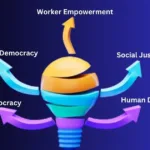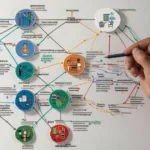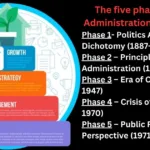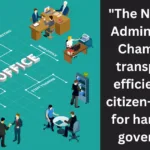E-governance, a pivotal paradigm in the realm of public administration, stands as a testament to the transformative power of technology in shaping the interaction between citizens and government entities. In its essence, e-governance encapsulates the seamless integration of information technology into the functioning of government processes, fostering transparency, efficiency, and citizen-centric services. As we delve into this multifaceted concept, we uncover not only its foundational principles but also the far-reaching implications it holds for modern societies striving for enhanced governance and connectivity. This exploration unveils the intricate tapestry of e-governance, where the convergence of digital tools and administrative acumen redefines the landscape of public service delivery.
What is e-governance?
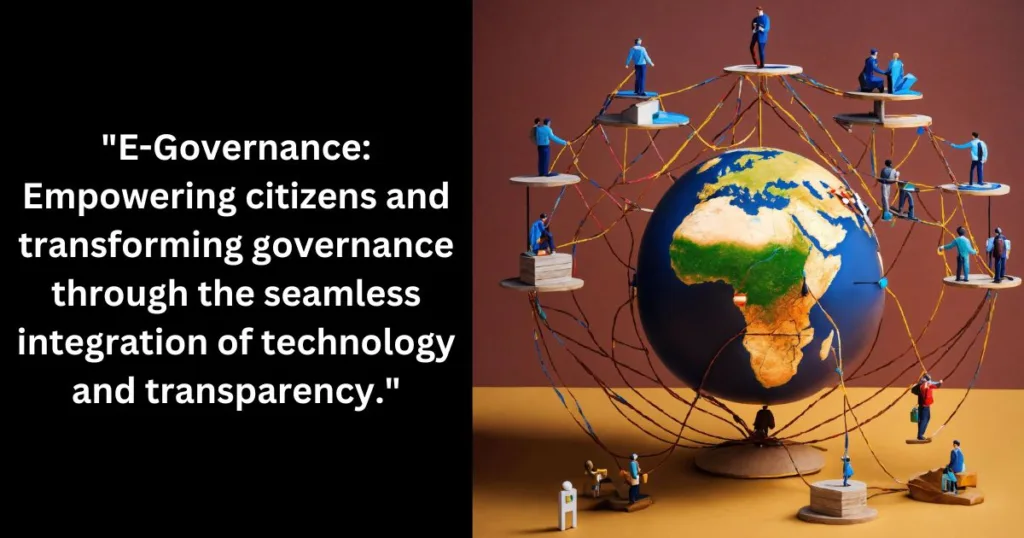
1. “According to the renowned scholar, Adegboyega Ojo, E-governance is the utilization of information and communication technologies to facilitate government processes, enhance public service delivery, and foster citizen engagement, ultimately contributing to more effective and accountable governance.”
2. “In the words of Subhash Bhatnagar, a distinguished academic in the field, E-governance involves the application of digital tools to restructure governance mechanisms, making them more responsive, transparent, and accessible to citizens.”
3. “Renowned scholar Marijn Janssen defines E-governance as the strategic use of information and communication technologies in public administration to improve decision-making processes, increase efficiency, and strengthen the relationship between the government and its constituents.”
4. “According to the insights of Evgeny Styrin, a prominent researcher in E-governance, it is the integration of digital technologies into governmental operations, leading to the creation of more inclusive, participatory, and responsive systems of governance.”
5. “In the scholarly work of Vishanth Weerakkody, E-governance is articulated as the dynamic and continuous process of employing information technology to enhance government functionality, optimize service delivery, and fortify democratic governance in the digital age.”
Objectives of E-Governance 2.0
1. Enhanced Service Delivery:
E-governance aims to improve the efficiency and accessibility of public services, ensuring that citizens can easily access government information and services online.
2. Transparency and Accountability:
One of the primary objectives is to foster transparency in government operations, making information readily available to the public. This transparency, coupled with accountability measures, helps build trust between the government and its citizens.
3. Citizen Empowerment:
E-governance seeks to empower citizens by providing them with the tools and platforms to actively participate in decision-making processes, contributing to a more inclusive and democratic governance structure.
4. Operational Efficiency:
Streamlining administrative processes through digital technologies is a key objective, aiming to reduce bureaucratic delays, enhance workflow efficiency, and optimize resource utilization within government organizations.
5. Cost Savings and Resource Optimization:
E-governance endeavors to minimize costs associated with traditional paperwork and manual processes. By leveraging technology, governments aim to optimize resource allocation and improve fiscal responsibility.
6. Digital Inclusion:
Ensuring that all segments of the population have access to and benefit from digital government services is a global objective. E-governance initiatives aim to bridge the digital divide, making services accessible to diverse socio-economic groups.
7. Innovative Policy Implementation:
E-governance facilitates the implementation of innovative policies and strategies, allowing governments to adapt more swiftly to changing societal needs and challenges.
8. Security and Data Privacy:
Ensuring the security of digital systems and safeguarding citizens’ data privacy are paramount objectives in E-governance initiatives to build trust in online government interactions.
9. Cross-Agency Collaboration:
E-governance encourages collaboration and information-sharing among different government agencies, promoting a more integrated and cohesive approach to public service delivery.
10. Adoption of Emerging Technologies:
Keeping pace with technological advancements, E-governance aims to leverage emerging technologies such as artificial intelligence, blockchain, and data analytics to enhance government functions and services.
Highlighting the key goals and purposes:
E-governance, with its transformative potential, is driven by key goals and purposes that redefine the dynamics of governance in the digital age:
1. Enhanced Accessibility:
E-governance seeks to make government services and information easily accessible to all citizens, fostering inclusivity and ensuring that geographical and physical constraints do not hinder engagement.
2. Transparency and Accountability:
A core objective is to establish transparent processes, making government activities and decisions visible to the public. This transparency, coupled with accountability mechanisms, aims to build trust and confidence in governmental actions.
3. Efficient Service Delivery:
The primary purpose is to streamline and optimize service delivery through digital channels, reducing bureaucratic hurdles, minimizing delays, and improving overall efficiency in meeting citizen needs.
4. Citizen Participation and Engagement:
E-governance encourages active citizen participation in decision-making processes, seeking to empower individuals to contribute to governance, provide feedback, and be involved in shaping public policies.
5. Cost-Efficiency and Resource Optimization:
By leveraging technology, e-governance aims to reduce costs associated with traditional paper-based processes, enhance resource allocation, and promote fiscal responsibility within government organizations.
6. Innovation and Adaptability:
E-governance strives to foster a culture of innovation within government operations, enabling swift adaptation to emerging technologies and the dynamic needs of a rapidly evolving society.
7. Digital Inclusion:
Ensuring that all segments of the population have access to and benefit from digital government services is a fundamental goal. E-governance initiatives aim to bridge the digital divide and promote equitable access.
8. Security and Data Privacy:
Safeguarding citizens’ data and ensuring the security of digital systems are paramount. E-governance initiatives focus on implementing robust cybersecurity measures and upholding the highest standards of data privacy.
9. Cross-Agency Collaboration:
E-governance promotes collaboration and information-sharing among different government agencies, fostering a more integrated and cohesive approach to public service delivery.
10. Continuous Improvement:
A key purpose is to create a framework for continuous improvement, where feedback mechanisms, data analytics, and technological advancements contribute to the ongoing enhancement of government processes and services.
Categories of E-governance:
1. G2C (Government-to-Citizen):
– Involves the delivery of government services directly to citizens. Examples include online portals for applying for permits, accessing healthcare information, and paying taxes.
2. G2B (Government-to-Business):
– Focuses on interactions between government entities and businesses. This category includes online platforms for business registration, licensing, and procurement processes.
3. G2G (Government-to-Government):
– Involves electronic communication and data exchange between different government agencies. This category streamlines inter-agency collaboration, reducing redundancies and improving overall efficiency.
4. G2E (Government-to-Employee):
– Encompasses the use of technology to manage internal government processes, including HR management, payroll systems, and communication tools for government employees.
5. C2G (Citizen-to-Government):
– Facilitates citizen interaction with government through feedback, complaints, and participation in decision-making processes. Social media engagement and online surveys are examples of C2G interactions.
6. M-Governance (Mobile Governance):
– Focuses on delivering government services and information through mobile devices. This category recognizes the increasing use of smartphones and mobile applications for accessing and providing government services.
7. E-Democracy:
– Involves utilizing digital platforms to enhance citizen participation in the democratic process. This includes online voting, digital consultations, and interactive decision-making forums.
8. Open Government Data (OGD):
– Involves making government data accessible to the public, promoting transparency and encouraging citizens, businesses, and researchers to use this data for various purposes.
9. Smart Governance:
– Integrates information and communication technologies to enhance the overall efficiency of city or regional governance. It includes the use of smart infrastructure, IoT devices, and data analytics for improved urban management.
10. Cloud Computing in Governance:
– Involves the use of cloud-based services for storage, processing, and sharing of government data and applications, contributing to increased accessibility and scalability.
By exploring these categories, we can understand the diverse facets of e-governance and how technology is applied across different domains to improve government functions and citizen interactions.
E-governance brings forth a multitude of benefits:
1. Enhanced Efficiency:
– Streamlining administrative processes through digital platforms reduces paperwork, automates routine tasks, and accelerates decision-making, resulting in overall operational efficiency.
2. Transparency and Accountability:
– E-governance promotes transparency by making government activities visible to the public. Access to information fosters accountability, as citizens can scrutinize government actions and hold officials responsible.
3. Improved Service Delivery:
– Citizens gain access to a range of government services online, leading to faster and more convenient service delivery. This accessibility is crucial for meeting the diverse needs of the population.
4. Cost Savings:
– Digitizing processes reduces the reliance on paper, minimizes manual interventions, and optimizes resource utilization, contributing to significant cost savings for both governments and citizens.
5. Citizen Empowerment:
– E-governance empowers citizens by providing them with information, enabling participation in decision-making, and offering platforms for expressing opinions, fostering a more engaged and informed citizenry.
6. Time Efficiency:
– Through automation and digital workflows, tasks that traditionally took considerable time can now be accomplished more swiftly. This includes online application submissions, approvals, and document processing.
7. Global Connectivity:
– E-governance transcends geographical boundaries, enabling governments to connect with citizens globally. This is particularly important for diaspora engagement and international collaboration.
8. Data-Driven Decision Making:
– Digital platforms generate vast amounts of data that can be analyzed to inform policy decisions. This data-driven approach enhances the government’s ability to understand trends, assess outcomes, and make informed choices.
9. Environmental Sustainability:
– A reduction in paper usage and the adoption of digital processes contribute to environmental sustainability. E-governance supports eco-friendly practices and aligns with global efforts to reduce carbon footprints.
10. Inclusive Governance:
– E-governance initiatives strive to bridge the digital divide, ensuring that citizens from diverse socio-economic backgrounds have access to and can benefit from digital services, promoting inclusive governance.
11. Quick Response to Citizen Needs:
– Real-time communication channels enable governments to respond promptly to citizen inquiries, complaints, and feedback, fostering a more responsive and citizen-centric approach.
12. Facilitation of E-Democracy:
– E-governance facilitates increased citizen participation in decision-making processes through online consultations, surveys, and forums, contributing to a more democratic and inclusive governance model.
In essence, the benefits of E-governance extend beyond administrative efficiency, touching upon fundamental principles of democracy, citizen engagement, and the responsible use of resources.
Governments globally have undertaken various initiatives:
1. Digital Transformation Programs:
– Governments initiate comprehensive digital transformation programs aimed at modernizing their systems, processes, and services. These programs often include the development of digital platforms, e-services, and the integration of emerging technologies.
2. Creation of E-Government Portals:
– Establishing centralized E-government portals serves as a common entry point for citizens to access a wide range of services. These portals provide a unified interface, simplifying the user experience.
3. Implementation of National ID Systems:
– Introducing national identification systems, often linked to digital databases, enhances the efficiency of citizen authentication and allows for seamless access to various government services.
4. Online Service Delivery Channels:
– Governments develop and promote online channels for delivering public services, such as applying for permits, paying taxes, and accessing official documents. This shift reduces reliance on physical paperwork and in-person transactions.
5. E-Government Legislation and Policies:
– Enacting specific legislation and policies that support the implementation of E-governance is crucial. Governments formulate legal frameworks that address issues such as data protection, cybersecurity, and digital accessibility.
6. ICT Infrastructure Development:
– Investing in Information and Communication Technology (ICT) infrastructure is fundamental. Governments establish robust digital networks, data centers, and connectivity to ensure the seamless functioning of E-governance systems.
7. Capacity Building and Training:
– Governments invest in training programs to equip public officials with the necessary skills to navigate and manage E-governance systems. This ensures a smooth transition and effective utilization of digital platforms.
8. Public Awareness Campaigns:
– Governments conduct public awareness campaigns to educate citizens about the benefits and functionalities of E-governance. These campaigns aim to encourage widespread adoption and use of digital services.
9. Collaboration with Private Sector:
– Collaborating with the private sector helps governments leverage external expertise and resources. Public-private partnerships can lead to innovative solutions, efficient service delivery, and the development of user-friendly interfaces.
10. Open Data Initiatives:
– Governments release datasets to the public as part of open data initiatives. This practice enhances transparency and encourages citizen engagement by allowing individuals, businesses, and researchers to use government data for various purposes.
11. Mobile Governance (m-Governance):
– Recognizing the prevalence of mobile devices, governments implement mobile applications and services to provide citizens with convenient access to information and services on their smartphones.
12. Regular System Audits and Reviews:
– Governments conduct regular audits and reviews of their E-governance systems to ensure security, functionality, and compliance with standards. This ongoing evaluation helps identify areas for improvement.
By undertaking these initiatives, governments aim to create a digital ecosystem that not only enhances administrative efficiency but also actively involves citizens in the governance process.
As of my last knowledge update in January 2022, I don’t have specific information on a “Technology Vision 2035” in India. However, I can provide a general concept of what a long-term technological vision might encompass based on common practices.
A Technology Vision, especially one for a long-term horizon like 2035:
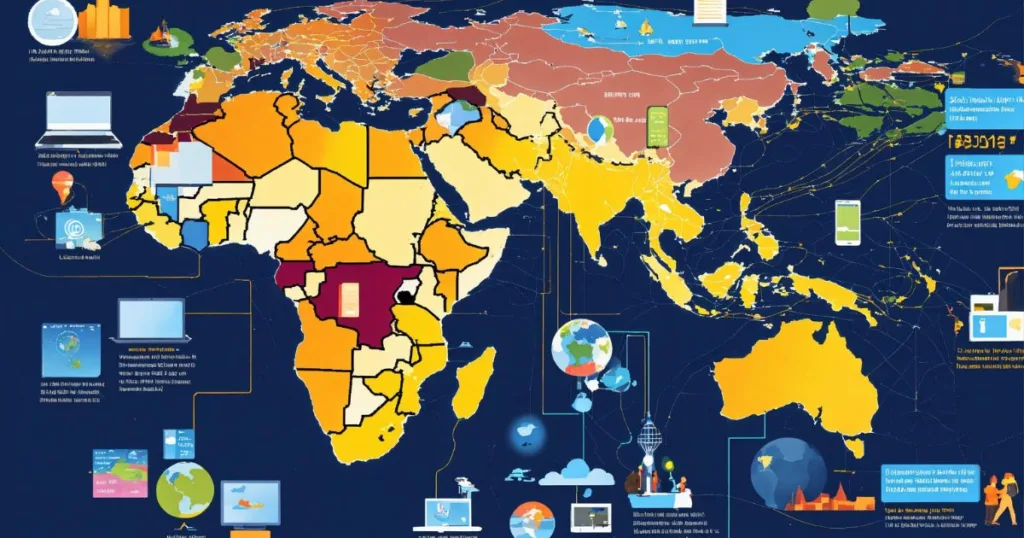
1. Digital Infrastructure Development:
– Focusing on the creation and enhancement of robust digital infrastructure, including high-speed internet connectivity, data centers, and technology hubs, to support a thriving digital economy.
2. Emerging Technologies Integration:
– Embracing and integrating emerging technologies such as artificial intelligence, blockchain, Internet of Things (IoT), and 5G to drive innovation across various sectors like healthcare, education, and industry.
3. Data Governance and Security:
– Establishing comprehensive frameworks for data governance, ensuring the responsible and secure use of data, while also fostering data-driven decision-making across government and private sectors.
4. Innovation Ecosystem:
– Cultivating an environment that encourages research, development, and innovation. This includes supporting startups, fostering collaboration between academia and industry, and creating incentives for technological breakthroughs.
5. Digital Literacy and Skill Development:
– Prioritizing initiatives that enhance digital literacy and skills among the population. This involves educational programs to equip individuals with the necessary skills for the digital era.
6. E-Governance and Citizen Services:
– Strengthening e-governance initiatives to make government services more accessible, efficient, and citizen-centric. This could involve the integration of digital platforms for various government functions.
7. Sustainable Technology Solutions:
– Promoting the development and adoption of sustainable technologies to address environmental challenges. This may include clean energy solutions, smart urban planning, and eco-friendly practices.
8. Cybersecurity Resilience:
– Prioritizing the development of robust cybersecurity measures to protect critical infrastructure, sensitive data, and digital systems from cyber threats and attacks.
9. Global Technological Leadership:
– Aspiring to establish India as a global leader in certain technological domains, potentially through fostering research excellence, international collaborations, and participation in global innovation networks.
10. Digital Inclusion:
– Ensuring that the benefits of technology reach all segments of society. This involves bridging the digital divide and creating inclusive policies that consider the needs of diverse populations.
It’s important to note that the specific goals and strategies outlined in a Technology Vision would depend on the country’s unique challenges, opportunities, and priorities. For the most accurate and up-to-date information on India’s Technology Vision 2035, it’s recommended to refer to official government publications or announcements.
Mobile Governance (m-Governance):
Definition:
Mobile Governance, often referred to as m-Governance, is a subset of electronic governance (e-governance) that involves the use of mobile devices, such as smartphones and tablets, to deliver government services and information to citizens. It leverages mobile technology to enhance the accessibility and efficiency of government services, allowing citizens to interact with public authorities on the go.
Significance:
1. Accessibility and Inclusivity:
– Mobile governance significantly enhances the accessibility of government services. As mobile devices become ubiquitous, citizens can access information and avail services irrespective of their location, bridging geographical gaps and promoting inclusivity.
2. Real-time Interaction:
– Mobile platforms enable real-time interaction between citizens and government agencies. This immediacy is particularly valuable for services that require prompt responses, such as emergency alerts, health information dissemination, or quick updates on public services.
3. Convenience for Citizens:
– The ubiquity of mobile devices ensures that citizens can engage with government services at their convenience. This convenience is crucial for busy individuals who may not have the time to visit physical government offices.
4. Service Personalization:
– Mobile governance allows for personalized and targeted communication. Governments can tailor information and services based on individual preferences, creating a more user-centric and efficient service delivery model.
5. Digital Payments and Transactions:
– Mobile governance often incorporates digital payment systems, allowing citizens to make transactions, pay bills, and receive benefits through mobile applications. This contributes to the digitization of financial processes and reduces reliance on cash transactions.
6. Healthcare and Emergency Services:
– Mobile platforms facilitate the delivery of healthcare information, appointment scheduling, and emergency alerts. This is particularly impactful in healthcare systems, where timely information can be critical.
7. Participatory Governance:
– Mobile applications can be utilized to engage citizens in participatory governance. Through surveys, feedback mechanisms, and interactive forums, governments can involve citizens in decision-making processes and policy discussions.
8. Data Collection and Analytics:
– Mobile governance enables efficient data collection in real-time. Governments can gather valuable insights through mobile applications, aiding in data-driven decision-making and policy formulation.
9. Disaster Management:
– During emergencies or natural disasters, mobile governance plays a crucial role in disseminating timely information, coordinating relief efforts, and facilitating communication between authorities and affected citizens.
10. Reduced Bureaucratic Delays:
– By allowing citizens to interact with government services directly through mobile devices, bureaucratic delays associated with traditional processes can be minimized, leading to quicker service delivery.
In summary, mobile governance harnesses the power of mobile technology to make government services more accessible, efficient, and citizen-friendly. It aligns with the changing patterns of communication and behavior in the digital age, promoting a more responsive and inclusive form of governance.
Importance of Mobile Governance:

1. Ubiquitous Connectivity:
– Mobile devices have become pervasive, providing an unparalleled reach to citizens. Mobile governance leverages this ubiquity, ensuring that government services and information are accessible to a wide and diverse population.
2. Real-time Communication:
– In the current scenario, where timely information is crucial, mobile governance enables governments to communicate with citizens in real-time. This is particularly vital for emergency alerts, public health updates, and other time-sensitive announcements.
3. Convenience and Accessibility:
– Mobile governance brings government services directly to citizens’ fingertips, enhancing convenience. This is especially relevant in a fast-paced world where individuals may not have the time or means to visit physical government offices.
4. Enhanced Citizen Engagement:
– Through mobile applications, governments can engage citizens in a more interactive manner. Surveys, feedback mechanisms, and participatory features empower citizens to actively contribute to decision-making processes, fostering a sense of involvement.
5. Digital Payments and Transactions:
– Mobile governance integrates digital payment systems, contributing to the digitization of financial transactions. This is critical in the current scenario as economies strive for cashless transactions and enhanced financial inclusivity.
6. Health Information Dissemination:
– The importance of mobile governance is evident in disseminating health information, especially during health crises. Mobile platforms are instrumental in delivering updates, guidelines, and facilitating healthcare services, contributing to public health awareness.
7. Efficient Service Delivery:
– Mobile governance reduces bureaucratic delays by enabling citizens to access and avail government services quickly and efficiently. This is essential in meeting the increasing demands for streamlined and responsive service delivery.
8. Data-Driven Decision Making:
– Mobile governance facilitates data collection and analytics, providing governments with valuable insights into citizen preferences, behaviors, and needs. In the current scenario, data-driven decision-making is crucial for effective policy formulation and resource allocation.
9. Disaster Management and Emergency Response:
– During disasters and emergencies, mobile governance plays a pivotal role in coordinating response efforts. Governments can use mobile platforms to communicate evacuation plans, deliver emergency alerts, and provide critical information to affected populations.
10. Inclusive Governance:
– The importance of mobile governance lies in its ability to promote inclusive governance. By ensuring that government services are accessible through mobile devices, it addresses the digital divide and ensures that a broader spectrum of the population can benefit.
11. Cost-Effective Solutions:
– Mobile governance often provides cost-effective solutions for governments. It reduces the need for physical infrastructure and manual processes, leading to cost savings and improved resource utilization.
In the current era of digital transformation and rapid technological advancements, mobile governance emerges as a crucial tool for governments to connect with citizens, deliver services efficiently, and foster a more inclusive and responsive form of governance.
Obstacles and Challenges in E-Governance:
1. Digital Divide:
– The disparity in access to technology and the internet among different socio-economic groups and regions poses a significant challenge. The digital divide can hinder the equitable implementation of e-governance initiatives, leaving certain populations underserved.
2. Technological Infrastructure:
– Inadequate or outdated technological infrastructure can impede the successful implementation of e-governance. Insufficient network connectivity, outdated hardware, and a lack of interoperability between systems can pose significant challenges.
3. Cybersecurity Concerns:
– E-governance systems are vulnerable to cyber threats, including data breaches and cyber attacks. Ensuring robust cybersecurity measures to protect sensitive information and maintain the integrity of digital platforms is a constant challenge.
4. Privacy Issues:
– The collection and storage of vast amounts of personal data raise concerns about privacy. Governments must navigate the delicate balance between utilizing citizen data for improved services and safeguarding individual privacy rights.
5. Resistance to Change:
– Resistance to adopting new technologies among government officials, employees, and citizens can hinder the smooth transition to e-governance. Overcoming resistance requires effective change management strategies and awareness campaigns.
6. Lack of Digital Literacy:
– Insufficient digital literacy among citizens can be a major obstacle. For e-governance to be effective, citizens need to be familiar with digital tools and platforms. Educational programs are crucial to address this challenge.
7. Complex Bureaucratic Processes:
– E-governance initiatives often encounter challenges in simplifying complex bureaucratic processes. Adapting traditional processes to digital platforms requires careful planning and may face resistance from established administrative structures.
8. Interoperability Issues:
– Lack of interoperability between different e-governance systems and databases can lead to inefficiencies. Seamless integration is crucial for exchanging information across various government departments and agencies.
9. Financial Constraints:
– Limited financial resources can impede the development and maintenance of e-governance infrastructure. Governments may face challenges in allocating sufficient funds for technological investments, training programs, and system updates.
10. Inadequate User Engagement:
– Successful e-governance requires active user engagement. If citizens are not sufficiently engaged or aware of available services, the initiative may not realize its full potential. Effective communication strategies are essential to overcome this challenge.
11. Legal and Regulatory Frameworks:
– Developing appropriate legal and regulatory frameworks to govern e-governance initiatives is a complex task. Ensuring compliance with existing laws while addressing emerging challenges in the digital space requires careful consideration.
12. Sustainability and Scalability:
– Ensuring the sustainability and scalability of e-governance projects can be challenging. Long-term planning and continuous innovation are necessary to keep pace with evolving technologies and changing societal needs.
Identifying and addressing these challenges is crucial for the successful implementation and sustained effectiveness of e-governance initiatives. Governments must adopt adaptive strategies and collaborate with stakeholders to overcome these obstacles.
Measures to Overcome Challenges in E-Governance:

1. Digital Inclusion Initiatives:
– Implement programs to bridge the digital divide, ensuring that citizens from all socio-economic backgrounds have access to digital tools. This may involve providing subsidized devices, promoting community digital literacy programs, and offering internet connectivity solutions.
2. Upgrading Technological Infrastructure:
– Invest in modernizing technological infrastructure to support e-governance initiatives. This includes improving network connectivity, updating hardware and software systems, and ensuring interoperability between different platforms.
3. Robust Cybersecurity Measures:
– Implement comprehensive cybersecurity protocols, including encryption, secure data storage, and continuous monitoring. Regular audits and updates to security systems help protect against evolving cyber threats.
4. Privacy-by-Design Approach:
– Adopt a privacy-by-design approach in e-governance systems. Ensure that privacy considerations are integrated into the design and development stages, and implement transparent data handling practices to build trust with citizens.
5. Change Management Programs:
– Develop and execute change management programs to address resistance to technology adoption. Training sessions, workshops, and awareness campaigns can help government officials, employees, and citizens embrace and adapt to e-governance changes.
6. Promoting Digital Literacy:
– Launch comprehensive digital literacy programs targeting citizens of all age groups. Educational initiatives should focus on basic digital skills, online safety, and understanding how to interact with e-governance platforms.
7. Simplification of Bureaucratic Processes:
– Undertake a comprehensive review and redesign of bureaucratic processes to simplify and streamline them for digital platforms. This may involve reengineering workflows, reducing unnecessary steps, and enhancing user-friendly interfaces.
8. Interoperability Standards:
– Establish interoperability standards to facilitate seamless communication between different e-governance systems. This ensures that data can be shared efficiently across various government departments and agencies.
9. Strategic Financial Planning:
– Develop long-term financial plans to sustain e-governance initiatives. Governments should allocate adequate funds for initial infrastructure development, ongoing maintenance, and the implementation of necessary updates and upgrades.
10. User Engagement Strategies:
– Implement effective user engagement strategies, including user-friendly interfaces, accessible customer support, and targeted awareness campaigns. Citizen feedback mechanisms should be incorporated to continually enhance user experiences.
11. Legislative and Regulatory Frameworks:
– Establish clear legislative and regulatory frameworks to govern e-governance initiatives. Ensure that these frameworks are flexible enough to accommodate evolving technologies while maintaining robust standards for data protection, security, and user rights.
12. Innovation and Continuous Improvement:
– Foster a culture of innovation within government agencies. Encourage experimentation with new technologies, partnerships with the private sector, and a commitment to continuous improvement in e-governance systems and processes.
13. Collaboration with Stakeholders:
– Foster collaboration with various stakeholders, including private companies, NGOs, and international organizations. Partnerships can bring diverse expertise, resources, and perspectives to address challenges and promote sustainable e-governance solutions.
By implementing these measures, governments can navigate challenges, enhance the effectiveness of e-governance initiatives, and create a digital governance ecosystem that is inclusive, secure, and responsive to the evolving needs of citizens.
Conclusion:
In this comprehensive blog post, we delved into the multifaceted realm of E-governance, unraveling its intricacies, objectives, and global significance. Beginning with an insightful introduction, we navigated through the definition of E-governance and its pivotal role in reshaping traditional governance structures.
The exploration extended to key components, elucidating the various categories of E-governance, from Government-to-Citizen (G2C) interactions to Mobile Governance (M-Governance), reflecting the diverse ways technology integrates with government functions.
Our journey continued with an in-depth examination of the worldwide objectives of E-governance, shedding light on its role in enhancing service delivery, fostering transparency, and promoting citizen empowerment. Notably, the significance of emerging technologies and open data initiatives in achieving these objectives was emphasized.
To provide a nuanced perspective, we discussed the obstacles and challenges that E-governance initiatives often encounter. From the digital divide to cybersecurity concerns, each challenge was dissected, offering a comprehensive understanding of the complexities governments face in the digital era.
However, the narrative did not end with challenges; rather, we delved into measures to overcome these obstacles. Strategies such as digital inclusion initiatives, robust cybersecurity measures, and comprehensive change management programs were outlined, emphasizing the adaptive approaches required for successful E-governance implementation.
The exploration further extended to the significance of Mobile Governance, recognizing the transformative role of mobile devices in making government services more accessible, real-time, and citizen-centric. This discussion underscored the importance of technology in the current scenario, where digital connectivity is paramount.
Finally, frequently asked questions (FAQs) provided a concise recap, addressing common queries and reinforcing key insights. This journey through the landscape of E-governance unveiled its potential to redefine governance structures, promote inclusivity, and empower citizens in the digital age.
People Also Read: Good Governance: Powerful Concept, Meaning, Features, and Relevance
FAQs on E-Governance:
1. What is E-governance?
– E-governance refers to the use of digital technology, such as the internet and electronic devices, to enhance and streamline government processes, improve service delivery, and facilitate citizen engagement.
2. Why is E-governance important?
– E-governance is crucial for promoting transparency, efficiency, and accessibility in government operations. It enhances citizen participation, improves service delivery, and fosters a more inclusive and responsive form of governance.
3. What are the key objectives of E-governance?
– The key objectives of E-governance include enhancing service delivery, promoting transparency, fostering citizen empowerment, optimizing operational efficiency, and leveraging technology for innovative policy implementation.
4. What are the categories of E-governance?
E-governance is categorized into G2C (Government-to-Citizen), G2B (Government-to-Business), G2G (Government-to-Government), G2E (Government-to-Employee), C2G (Citizen-to-Government), M-Governance (Mobile Governance), E-Democracy, Open Government Data, Smart Governance, and Cloud Computing in Governance.
5. How does Mobile Governance contribute to E-governance?
– Mobile Governance utilizes mobile devices to deliver government services and information. It enhances accessibility, allows real-time interaction, and contributes to citizen empowerment by providing convenient access to services on smartphones.
6. What are the benefits of E-governance?
– The benefits of E-governance include enhanced efficiency, transparency, improved service delivery, cost savings, citizen empowerment, real-time communication, and the facilitation of data-driven decision-making.
7. What are the common challenges in E-governance?
– Common challenges in E-governance include the digital divide, technological infrastructure limitations, cybersecurity concerns, privacy issues, resistance to change, lack of digital literacy, complex bureaucratic processes, interoperability issues, financial constraints, and inadequate user engagement.
8. How can governments overcome challenges in E-governance?
– Governments can overcome challenges by implementing digital inclusion initiatives, upgrading technological infrastructure, adopting robust cybersecurity measures, promoting digital literacy, simplifying bureaucratic processes, establishing interoperability standards, and engaging in strategic financial planning.
9. What is the Technology Vision 2035 in India?
– As of my last knowledge update in January 2022, I don’t have specific information on Technology Vision 2035 in India. However, a technology vision typically outlines long-term goals and strategies for leveraging technology to drive innovation and progress.
10. How can citizens actively participate in E-governance?
– Citizens can actively participate in E-governance by using online platforms to access government services, providing feedback, participating in surveys, staying informed about digital initiatives, and engaging in digital democracy practices.



